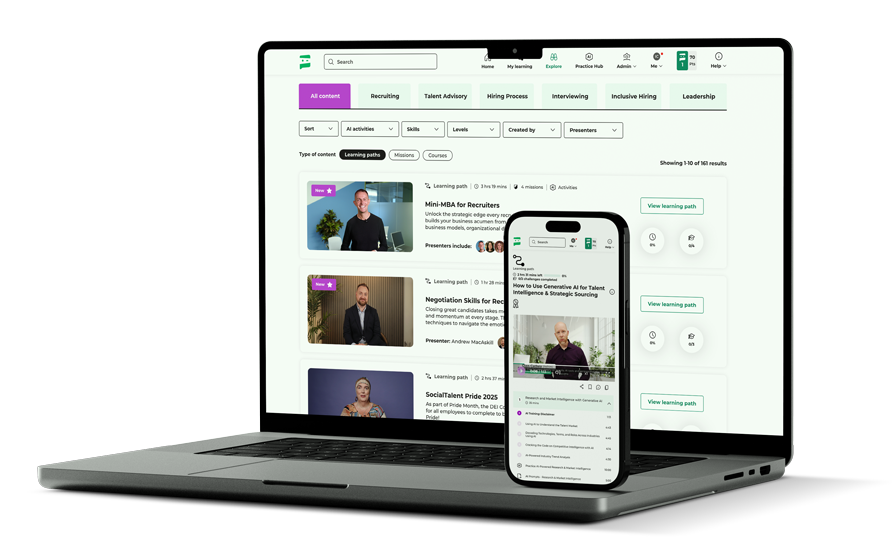
By David Deady
Stepping into the world of recruitment? Let’s decode the acronyms and jargon that’ll soon be flying around your inbox.
Every industry has its own language – but recruiting? It can feel like a different dialect entirely.
Reqs. Funnels. Sourcers. QITA (is that even a word?). If you’ve just started your recruiting career – or moved into a talent team for the first time – you’ve likely heard a few of these terms and nodded politely, unsure what half of them actually mean. Don’t worry. You’re not alone.
Inspired by our very own Irene Villar’s recruiting jargon buster course on the SocialTalent platform, this article will walk you through the foundational terms every new recruiter needs to know. You’ll learn what they mean, when to use them, and why they matter – so you can show up confident, informed, and ready to talk the talk.
7 Key Recruiting Terms You’ll Hear in Week One
1. Req (Short for “Requisition”)
This is the internal job order that kicks off a hiring process. A req is “opened” when a hiring manager gets approval to recruit for a new role, and it’s “closed” once someone is hired.
“We’ve just opened a new req for a marketing coordinator.”
2. 360 Recruiter / Full Lifecycle Recruiter (FLC)
This type of recruiter handles everything from start to finish – taking the job brief, writing the ad, sourcing, screening, interviewing, and managing the offer.
“As a 360 recruiter, you’re the single point of contact for the whole process.”
3. Sourcer
A specialist who focuses on finding talent (especially passive candidates), usually through platforms like LinkedIn. They start the outreach, then hand over to the recruiter for next steps.
“The sourcer already has a shortlist of potential profiles.”
4. Hiring Manager
The person in the business who’s hiring for a role. Often the team leader or department head, the hiring manager is a key decision-maker – and a vital stakeholder for recruiters.
“Loop the hiring manager in before you move that candidate forward.”
5. Recruitment Funnel
This is the journey a candidate goes through, from first contact to hired. It visualizes how the pool narrows at each stage:
Sourced → Screened → Shortlisted → Interviewed → Offered → Hired
“Let’s check where candidates are dropping off in the funnel.”
6. Outbound vs. Inbound Recruiting
Outbound = You go find the talent (think sourcing, headhunting).
Inbound = They come to you (think job ads, careers sites).
“We’re not getting enough inbound – time to ramp up sourcing.”
7. QITA (Qualified, Interested, Trusted, Affordable)
Used to assess whether a candidate is genuinely viable. Do they meet the specs, want the job, align with the company, and fit within budget?
“This candidate is great, but not QITA – they’re way over salary range.”
The ATS: Your Secret Weapon
If there’s one acronym that deserves its own spotlight, it’s this one: ATS – short for Applicant Tracking System.
An ATS is the software used to manage the end-to-end recruitment process. Think of it as your digital HQ for everything candidate-related. It can:
- Host job listings
- Receive and store applications
- Track candidates through the funnel
- Collect interview feedback
- Automate emails and comms
- Integrate with HR and payroll systems
Some common ATS tools include Taleo, Workday, Greenhouse, and Workable.
“An ATS boosts productivity and helps you make faster, better hiring decisions. It’s also a huge win for candidate experience.” — Irene Villar
But there’s a twist: not everyone loves using them. Hiring managers may prefer to give feedback over email or review CVs the “old school” way. You might need to advocate for the ATS – explaining how it streamlines communication, keeps candidate data secure, and speeds up the hiring process.
Bonus Terms You’ll Hear in Your First Month
Think of these as the next layer of lingo you’ll likely come across:
Screening
The initial stage where a recruiter assesses whether a candidate meets basic criteria. Often done via phone or video.
“I’ve screened her and she’s ready for an interview.”
Shortlist
A curated list of candidates being seriously considered for interviews.
“We’ve sent the hiring manager a shortlist of three.”
Time-to-Fill
A key metric that tracks how long it takes to fill a role from opening to offer.
“Our time-to-fill for engineering is creeping up – let’s look at the funnel.”
Passive Candidate
Someone not actively job-seeking but potentially open to the right opportunity. These are often the targets of outbound sourcing.
“This candidate wasn’t looking but took the call – that’s a great passive lead.”
EVP (Employer Value Proposition)
The unique mix of benefits, values, and culture that make your company attractive to candidates.
“Our EVP messaging isn’t landing with Gen Z talent – time for a refresh.”
Boolean Search
A structured search technique using operators like AND, OR, and NOT to narrow or broaden search results on platforms like LinkedIn, job boards, or ATS databases.
“Use a Boolean string like (“project manager” OR PM) AND Agile AND (“New York” OR Remote) to refine your search.”
Candidate Experience (CX)
How a candidate perceives your company’s hiring process—from first touch to final decision. A strong candidate experience builds employer brand and boosts offer acceptance rates.
“Let’s tighten up our comms – candidate experience is taking a hit post-interview.”
Ghosting
When a candidate (or sometimes a recruiter or hiring manager) suddenly stops responding without explanation. Sadly common in fast-paced or high-volume hiring.
“He ghosted after the final interview – no reply, no feedback.”
Purple Squirrel
A (usually unrealistic) candidate who’s a perfect match for every requirement—skills, experience, culture fit. Often used humorously.
“The hiring manager wants a purple squirrel with AI experience and retail ops.”
Final Thoughts: Don’t Be Afraid to Ask
If this list still feels like a lot, don’t worry – you’re not expected to memorize every acronym overnight. The most important thing? Stay curious. Ask questions. Own your learning.
Every recruiter starts somewhere, and every recruiter has, at some point, quietly Googled “what does req mean?”
So next time a term catches you off guard, raise your hand. Or better yet – send them this article!
Want to learn more?
Check out Irene Villar’s “Recruiting Jargon Buster” lesson and other expert-led content on the SocialTalent platform. You’ll build your skills, boost your confidence, and start speaking fluent recruiter in no time.




